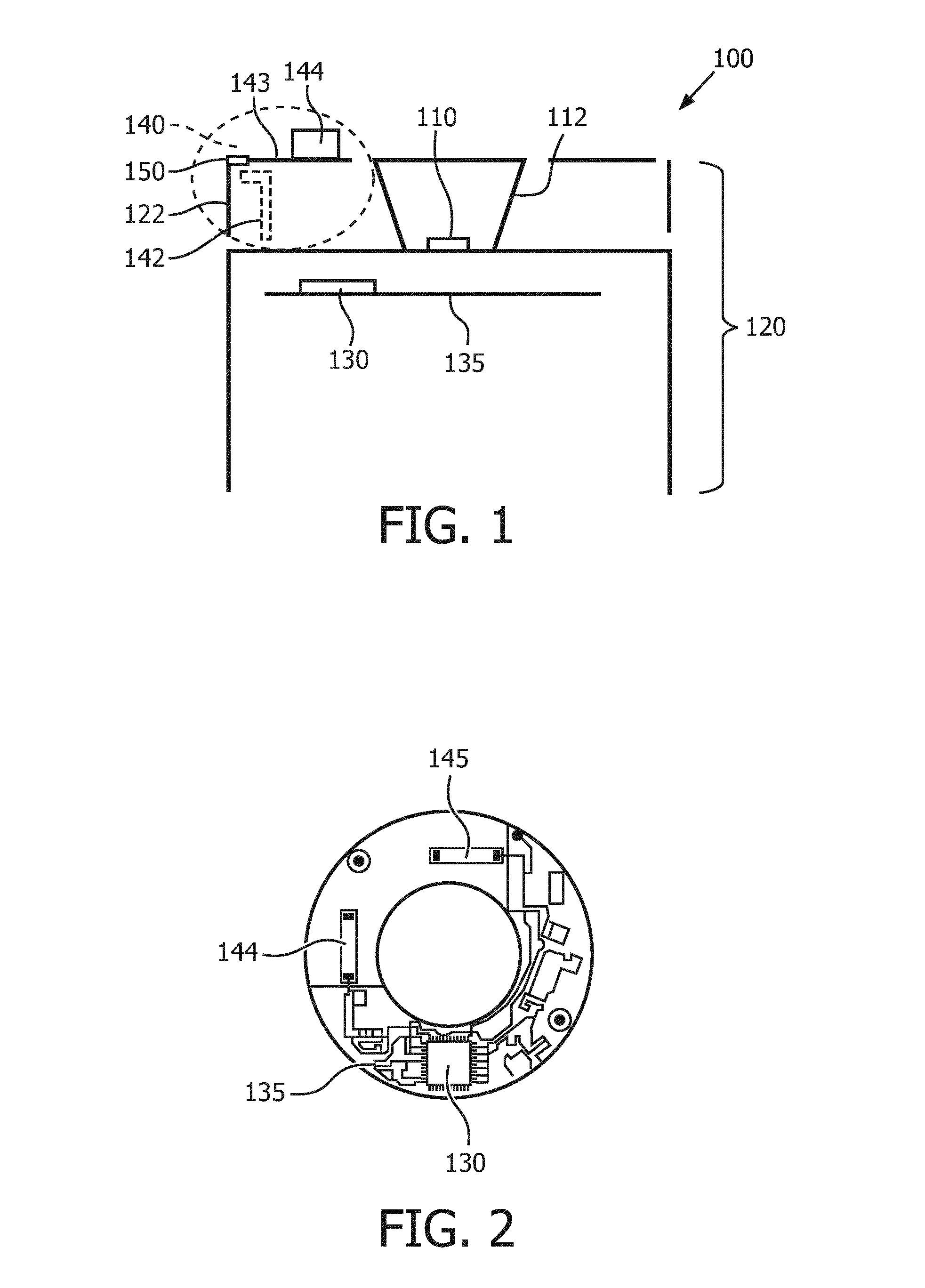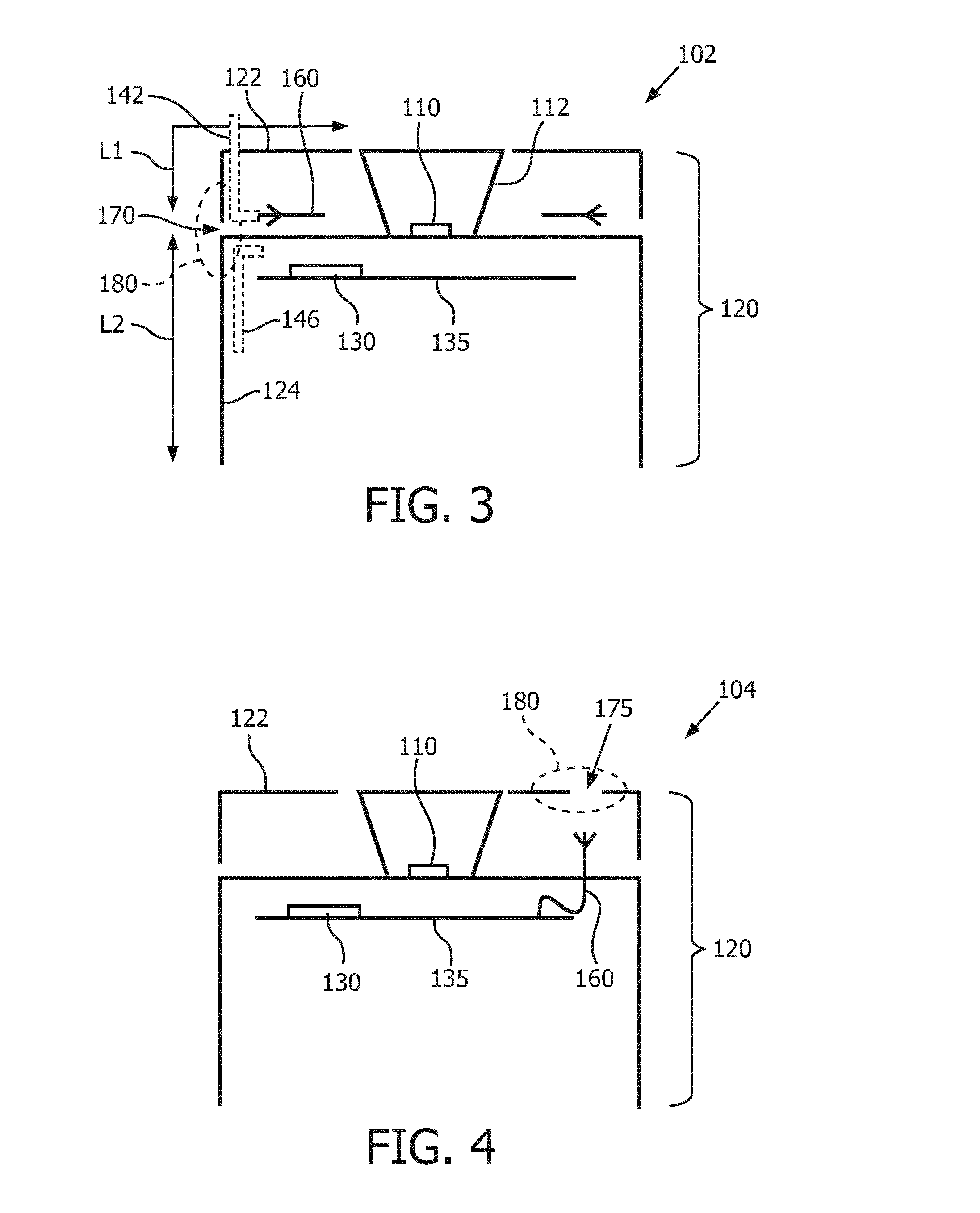A lighting device and luminaire comprising an antenna
a technology of lighting devices and luminaires, which is applied in the direction of resonant antennas, semiconductor devices for light sources, lighting and heating apparatus, etc., can solve the problems of practicability and feasible ways, and achieve the effect of improving the directivity of the antenna and improving the performance of the second radiator
- Summary
- Abstract
- Description
- Claims
- Application Information
AI Technical Summary
Benefits of technology
Problems solved by technology
Method used
Image
Examples
first embodiment
[0054]FIG. 1 shows a schematic cross-sectional view of the lighting device 100 according to the invention. This first lighting device comprises a light emitter 110 thermally connected to a heat sink 120 and comprises a communication circuit 130 arranged on a Printed Circuit Board (further also indicated as PCB) 135 for transmitting and / or receiving a communication signal. The heat sink 120 comprises a first conductive part 122 which comprises a first chip antenna 144 which is a first mono-pole antenna 144. Such first chip antenna 144 may be a commercially available chip antenna, often available as Surface Mount Devices (further also indicated as SMD) which can be mounted on a Printed Circuit Board (further also indicated as PCB). Alternatively, the first mono-pole antenna 144 may, for example, be a copper trace with predefined dimensions, printed on a PCB. The first conductive part 122 must be electrically conductive and may for example be made partially or wholly from metal or any ...
second embodiment
[0059]FIG. 3 shows a schematic cross-sectional view of the lighting device 102 according to the invention. The lighting device 102 shown in FIG. 3 also comprises the light emitter 110, heat sink 120, PCB 135 and communication circuit 130, similar as the embodiment shown in FIG. 1. Also the optional collimator 112 is shown in FIG. 3. The lighting device 102 in FIG. 3 further comprises a primary radiator 160 (two are drawn in FIG. 3, but only one has a label 160) arranged inside the heat sink 120 and configured for activating the first conductive part 122 around a gap 170 between the first conductive part 122 and the remainder of the heat sink 120. The primary radiator 160 typically is a dipole antenna 160 and the electro-magnetic signal emitted by the primary radiator 160 induces currents flowing around the gap 170 and as such activates the first conductive part 122 around the gap 170 which subsequently starts to emit a similar communication signal. So the primary radiator 160 activa...
third embodiment
[0062]FIG. 4 shows a schematic cross-sectional view of the lighting device 104 according to the invention. Also in the embodiment shown in FIG. 4, the light emitter 110, heat sink 120, PCB 135 and communication circuit 130 are shown, similar as the embodiment of FIG. 1. However, now, the gap in the first conductive part 122 comprises a slot 175 being an opening completely surrounded by the first conductive part 122. This slot 175 is the secondary radiator 180 (again indicated with a dotted oval) which has a resonance frequency including the signal frequency of the communication signal. The slot 175 acts as the dipole antenna 140 which may, for example, be activated by the primary radiator 160 such as the primary antenna 160 inside the heat sink 120. Again, the electro-magnetic signal emitted by the primary antenna 160 induces currents flowing around the slot 175 and as such activates the first conductive part 122 around the slot 175 which subsequently starts to emit a similar commun...
PUM
 Login to View More
Login to View More Abstract
Description
Claims
Application Information
 Login to View More
Login to View More - R&D
- Intellectual Property
- Life Sciences
- Materials
- Tech Scout
- Unparalleled Data Quality
- Higher Quality Content
- 60% Fewer Hallucinations
Browse by: Latest US Patents, China's latest patents, Technical Efficacy Thesaurus, Application Domain, Technology Topic, Popular Technical Reports.
© 2025 PatSnap. All rights reserved.Legal|Privacy policy|Modern Slavery Act Transparency Statement|Sitemap|About US| Contact US: help@patsnap.com



